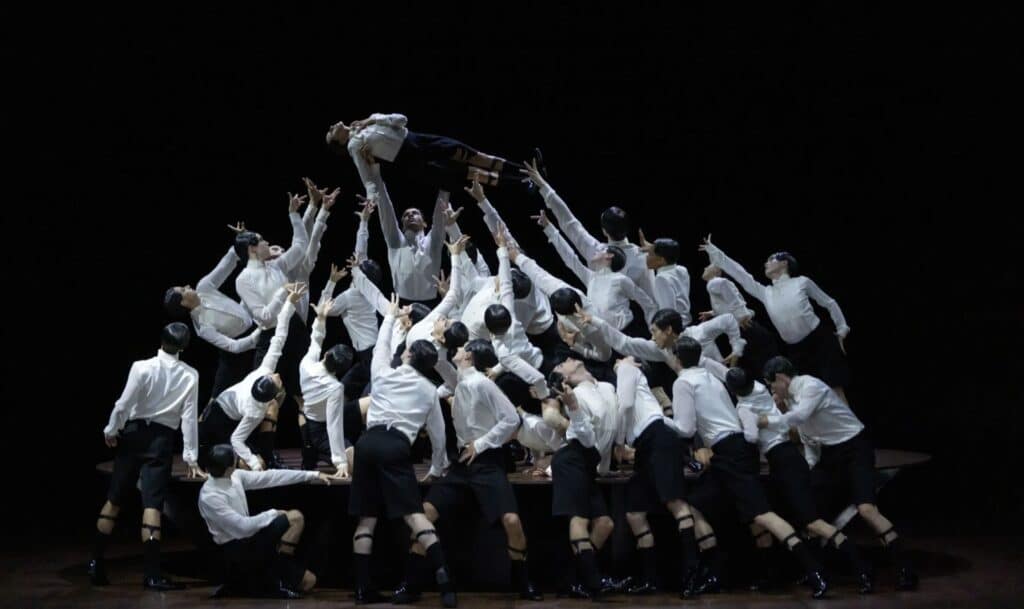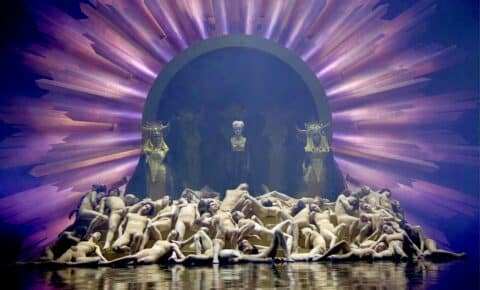NACHTTRÄUME/NIGHT DREAMS • ZÜRICH OPERA
★★★★★★

Photo: Gregory Batardon
REVIEW NACHTTRÄUME/NIGHT DREAMS: ABSOLUTELY EXCEPTIONAL TOTAL THEATRE IN ZURICH
I’ve simply never seen anything like it. Marcos Morau’s dance-with-more performance Nachtträume (Night Dreams) is playing to a full house at Zurich Opera House in a production that is a must-see for anyone involved in modern theatre.
The show is an astonishing hybrid of modern dance, physical theatre, cabaret, pumping percussion, ruthless house, and poetic classical, spectacularly unfolding in a set design that is at once hyper-minimalist and dizzyingly opulent.
The young, Spanish, Valencia-born choreographer Marcos Morau (41) deliberately aims for the opposite of tradition, ideal harmony and fluid movement. A take on ballet and fusion stage art that has won him several awards and made Morau a sought-after top name, both as an international freelancer and as the leader of his dance/theatre company La Veronal.
At the centre of this re-staging of the 2022 blockbuster that went under my radar and that I’ve only now become acquainted with, we find a gigantic round table over which a huge modernist chandelier in shiny chrome and glowing neon descends.
A wet designer dream with a strangely menacing undertone of Werner von Braun’s Saturn 5 rocket technology and dystopia.
With Nachtträume, Morau creates a bizarre kaleidoscope of movement, visual contrasts and rhythmic shifts that suggest dictatorship, oppression, frustration and crisis.
On stage is a 34-person dance troupe that functions as one large, synchronized organism, yet manages to bounce in all directions. The costuming is uniform in white shirts, black patent leather shoes, suit shorts and old-world suspenders. Soon they are equipped with one chair per nose and the chair game/separation race around the table of power can begin.
Over the course of the performance, the attire ranges from boarding school/business class to black sequin jackets and flowing glittery dresses. The dancers’ dynamics are lightning precise, shifting seamlessly between tight, mass choreographed discipline and complete chaos under full control.
The overall narrative is a kind of hallucination on themes such as individual versus group and revolution versus authority. It sounds wide open, and it is. In fact, Morau’s stated intention is for the audience to work to create some kind of action in the interpretive tableaux they are presented with.
As a kind of sprechstallmeister and recurring character, we find an egging drag queen (Ruben Drole) in a frivolous, bare-legged outfit, topped by a fierce tiara with tight-fitting diamonds that flash in the bright lighting.
Love me, he diabolically chants to the audience, love me as dreams love the night. I have come to guide you in the darkness.
When the chandelier releases a kind of surveillance drone densely populated with flashing cameras, it goes Big Brother and 1984, while the organism of dancers degenerates desperately and shrilly in both choreography and vocally, with shouts and screams from the stage. The old world is coming to an end and a new one must be born.
One spectacular stage design follows another in a journey through mixed emotions and equilibristic performance.
You sit on the edge of your seat to take it all in, hoping to understand everything better tomorrow…
The headless suit figures may have been seen before, but never so well, and so surreal, as when the 8-10 hidden dancers dismantle luminous glass balls from the chandelier, place them on their necks like illuminated eggheads and dance on into the hallucination.
I was almost dizzy when the same lights hung from the ceiling of the Schiller restaurant next to the opera house, where I soothed the experience with gintonics after the performance and the dreams didn’t seem to want to let go of their grip on me.
The finale, with a starry sky and two pianists on stage, each with their own concert grand piano, degenerates into pure lyricism as 30-40 sheep float through the space, carried almost invisibly by sequinned dancers to ethereal piano music by something reminiscent of Rachmaninov or Shostakovich.
The fabulous sound design is created by Barcelona composer/sound designer Clara Aguila in a kind of DJ mix with samples of Schubert and Kurt Weil, among others. Dazzling.
Zürich Ballet realised Morau’s artistic intentions in an exemplary manner and has many exciting productions on the plate for the coming season.
Nachtträume is stage art of an astonishing calibre and I have to say that the audience was absolutely thrilled during the evocations. Six stars from GOT TO SEE THIS for this sublime production, which, in addition to a rich theatre experience, gave me new, innovative contemporary artists at a high creative level to keep a close eye on in the future.



![★★★★★☆ REVIEW IL TROVATORE: DEVILISHLY GOOD VERDI IN ZURICH iltrovatore_c_monikarittershaus_132[1]](https://detskuduse.dk/wp-content/uploads/2022/10/iltrovatore_c_monikarittershaus_1321-480x270.jpg)
